25 High-Fiber Whole Grains That Will Transform Your Digestive Health (Complete Guide)

So here’s something that blew my mind: bulgur has 8.2 grams of fiber per cup. That’s way more than the brown rice I’d been eating thinking I was being healthy! I discovered this little fact while I was desperately googling solutions for my digestive issues at 2 AM (we’ve all been there, right?). I’d been reaching for the same old brown rice and oatmeal, completely clueless that there were whole grains high in fiber out there packing nearly double the punch.
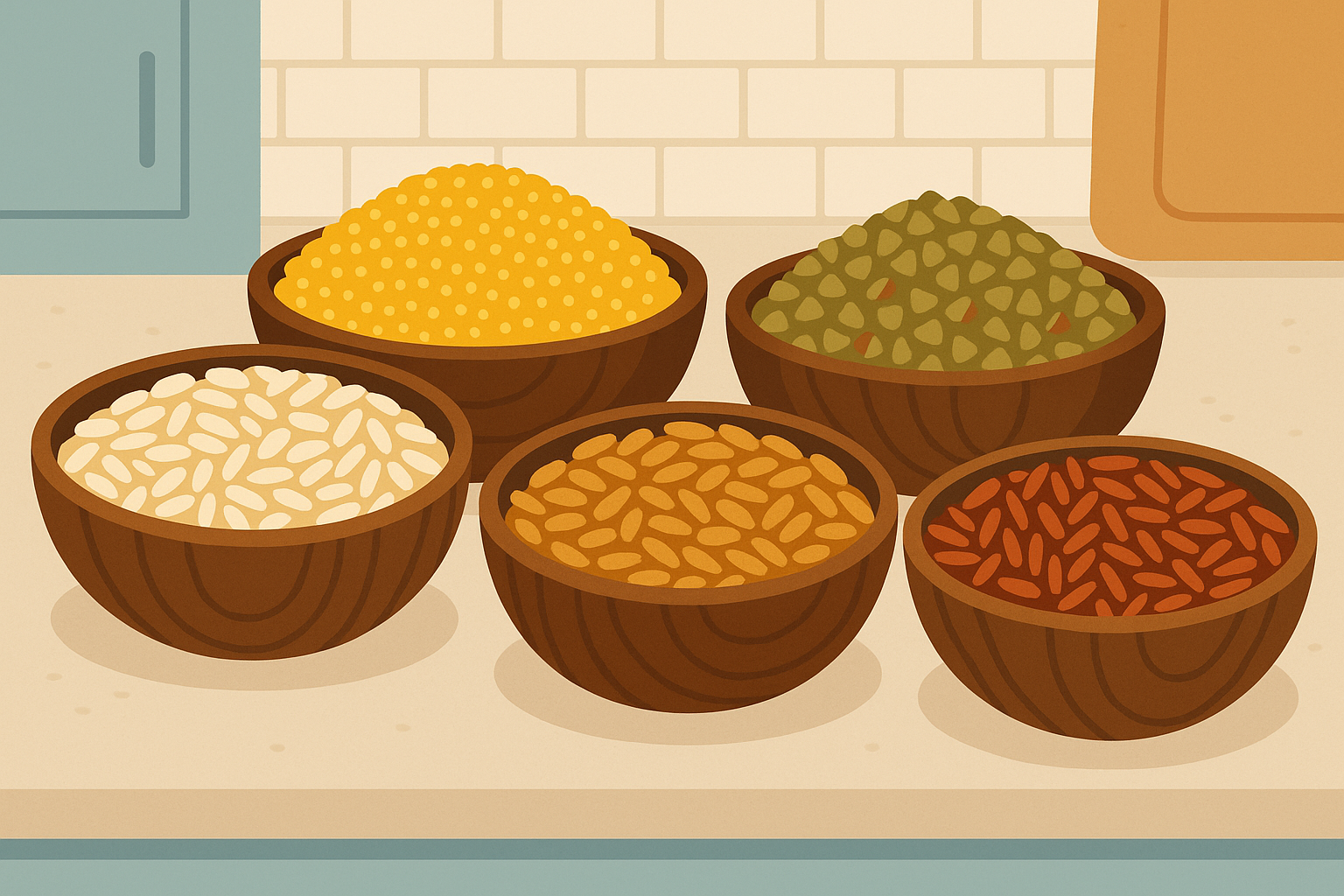
Here’s the thing that’ll make you want to bang your head against the wall: most of us are getting maybe half the fiber we need daily. We’re supposed to hit around 28 grams (and honestly, many experts think we need closer to 38), but most Americans are limping along with way less. You’re probably wondering which grains can actually move the needle on your fiber game without turning every meal into a cardboard-flavored punishment.
Look, understanding why fiber is so good for your health goes way beyond just keeping things moving smoothly, if you know what I mean. These grains are like little nutritional powerhouses that help with everything from keeping your heart happy to not crashing after lunch.
Okay, so I’ve organized these 25 grains in a way that actually makes sense – no more wandering around the grocery store feeling completely lost. We’ll cover everything from ancient grains that sound fancy but are surprisingly easy to cook, to quick options for when you’re running late (again). I promise you’ll find something that works for your lifestyle, whether you’re a meal prep queen or someone who considers cereal a food group.
Table of Contents
- What to Actually Think About When Picking High-Fiber Grains
- Ancient Grain Powerhouses (The Overachievers)
- Everyday Nutritional Staples (Your Reliable Friends)
- Gluten-Free Champions (Safe Options That Don’t Suck)
- Quick-Cooking Convenience Options (For When Life Happens)
- Specialty and Unique Options (For Your Adventurous Side)
- The Organic Authority Approach to High-Fiber Whole Grains
- Final Thoughts
TL;DR
- Start with fiber content as your main thing—look for grains with at least 3-4 grams, but the real winners have 6+ grams per serving
- Ancient grains like amaranth, teff, and freekeh are basically the overachievers of the grain world (7-8 grams per cup) and packed with good stuff
- How processed it is matters big time—steel-cut oats beat instant oats, whole kernels beat flour versions every single time
- Gluten-free doesn’t mean fiber-free—black rice, sorghum, and millet deliver without the digestive drama
- Quick-cooking varieties like rolled oats and pre-cooked quinoa save your sanity without sacrificing the good stuff
- Specialty grains like Ethiopian blue barley (yes, that’s a real thing) are perfect when you want to feel fancy
- Go slow when you start—your stomach will thank you for not jumping straight into the deep end
- Organic and local when possible because being kind to yourself and the planet feels good
What to Actually Think About When Picking High-Fiber Grains
Choosing high-fiber grains isn’t rocket science, but it’s also not just grabbing whatever’s on sale and hoping for the best. Trust me, I’ve made that mistake more times than I care to admit.
Fiber content is obviously your starting point, but here’s what most people don’t realize—it’s not just about the number on the package. We want grains that give you at least 3-4 grams per serving, though the real superstars pack 6+ grams into each cup. But here’s the kicker: the type of fiber matters just as much. Think of soluble fiber as your heart’s best friend and insoluble fiber as your gut’s personal trainer—they both do important but different jobs.
| Fiber Type | What It Actually Does | Where to Find It | How Much You Need |
|---|---|---|---|
| Soluble Fiber | Keeps cholesterol in check, stops blood sugar spikes, feeds the good gut bugs | Oats, barley, amaranth, teff | 10-15g daily |
| Insoluble Fiber | Keeps things moving, prevents that backed-up feeling, adds bulk | Wheat berries, brown rice, wild rice | 15-20g daily |
| Resistant Starch | Acts like a prebiotic, helps with insulin, fights inflammation | Cooled cooked grains, green bananas | 5-10g daily |
How packed with good stuff it is goes way beyond just fiber. The best grains are like little nutritional treasure chests—they’re giving you protein, minerals (iron, magnesium, zinc), B vitamins, and antioxidants all in one package. You want grains that multitask, not just fiber padding.
How processed it is can make or break everything. Steel-cut oats absolutely demolish instant oats when it comes to keeping your blood sugar steady and actually filling you up. Whole grain kernels beat flour versions every single time, and ancient grains in their complete form are basically nutritional gold.
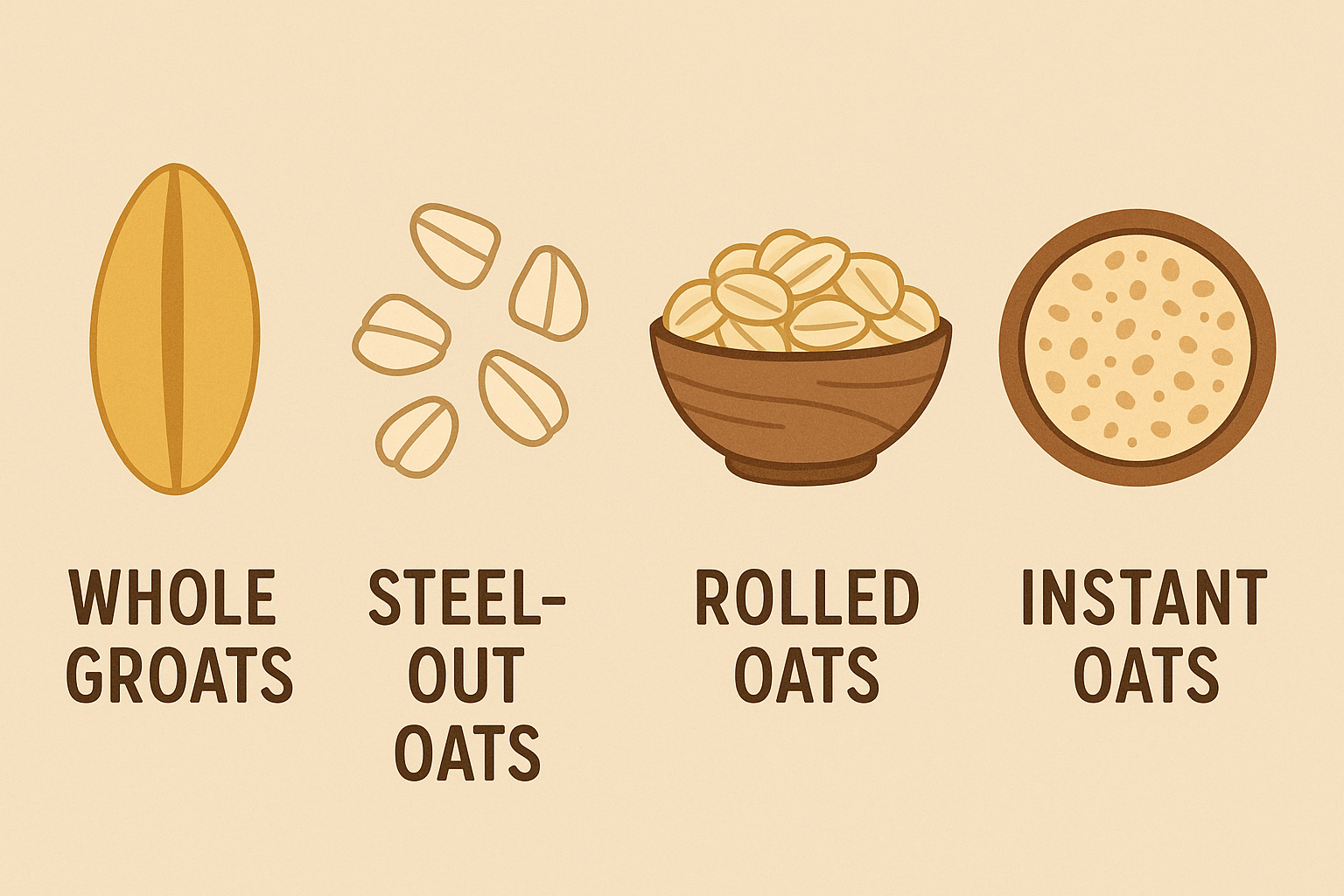
How your stomach handles it is huge, especially if you’re ramping up your fiber game. Some grains need soaking or take forever to cook, while others are ready in minutes. Pro tip from someone who learned the hard way: start slow with new grains unless you want to spend quality time with your bathroom.
When you’re getting serious about high fiber food lifestyle changes, it helps to know simple ways to beat bloat and improve digestion so you don’t feel miserable while your body adjusts.
Being kind to the planet matters too. Organic grains mean you’re avoiding synthetic junk and usually supporting farmers who actually care about soil health. Local and seasonal options are often fresher and support your community—it’s a win-win situation.
Will you actually eat it? is the question that determines whether all this planning actually works. Some grains are breakfast superstars, others shine at dinner, and some are perfect for meal prep. If you hate the taste or texture, all the fiber in the world won’t help you.
Here’s my biggest rookie mistake: I jumped straight into the heavy hitters like freekeh and farro (8+ grams per cup) thinking more was better. My digestive system basically went on strike for a week. What I should have done was start with familiar 4-gram options like brown rice and rolled oats, then slowly introduced one new grain every couple of weeks. Your gut needs time to adjust, and your confidence needs time to build with cooking techniques.
Ancient Grain Powerhouses (The Overachievers)
These are the grains that have been around forever and somehow managed to keep all their nutritional superpowers intact. They’re basically the overachievers of the grain world—they’ve survived thousands of years without anyone messing with their genetics, so they’re still packed with everything nature intended.
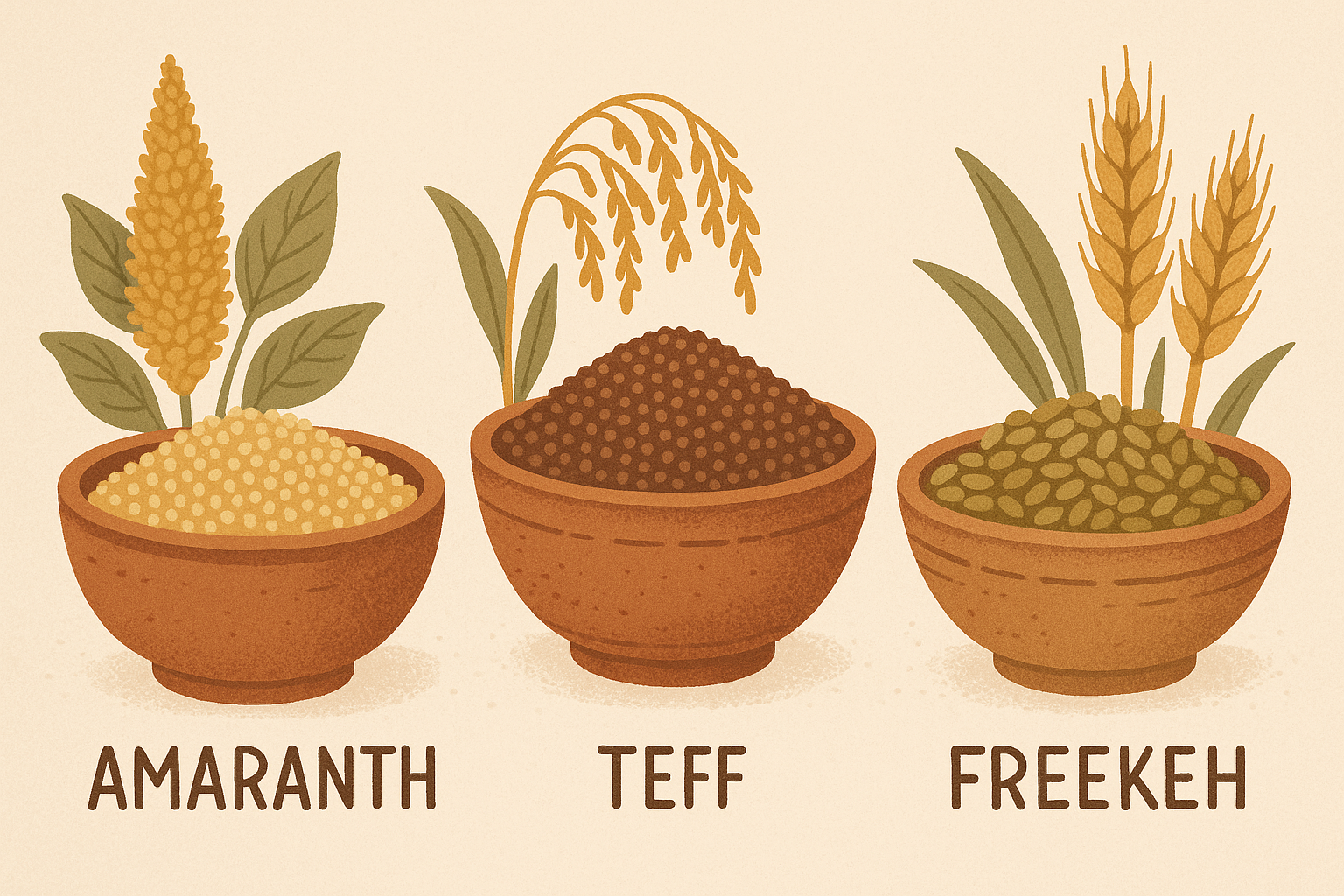
1. Amaranth (7g fiber per cup cooked)
This little grain (technically it’s not even a grain, but who’s counting?) is gluten-free and has complete protein, which is pretty rare in the plant world. It tastes nutty and slightly peppery, and you can pop it like tiny popcorn for snacks or cook it into porridge. Fair warning: it can get a bit gluey if you overcook it, but that’s not necessarily bad if you’re going for a creamy texture.
The fiber in amaranth is the real deal—both types working together to keep your digestive system happy. Plus you’re getting complete protein, iron, magnesium, and phosphorus all in one package. It’s pretty much unprocessed when you buy it whole, though your stomach might need some time to get used to it.
Amaranth is also a drought-resistant superstar that doesn’t need tons of water or chemicals to grow, so you can feel good about eating it. You can use it in breakfast bowls, salads, baking, or even make those cute little popped amaranth snacks that look fancy but are actually super easy.
2. Teff (7g fiber per cup cooked)
This tiny Ethiopian grain is seriously impressive for something so small. It’s got resistant starch, which is like premium fuel for the good bacteria in your gut. The flavor is mild and nutty, making it way more versatile than you’d expect, and it’s naturally gluten-free.
What makes teff special is that mix of different fiber types plus that resistant starch bonus. You’re also getting protein, iron, calcium, and even some vitamin C (which is weird for a grain, but we’ll take it). It’s basically unprocessed when you buy it, and most people’s stomachs handle it pretty well.
Teff doesn’t need much water or fertilizer to grow, which is great for the planet. You can make it into porridge, grind it into flour for that traditional injera bread, or just use it in grain bowls and pilafs. It’s like the Swiss Army knife of grains.
3. Freekeh (8g fiber per cup cooked)
This is young green wheat that’s been roasted and cracked, which gives it this amazing smoky flavor and satisfying chewy texture. It’s got more fiber than quinoa and won’t spike your blood sugar as much as brown rice, so it’s pretty much a winner all around.
Freekeh is loaded with insoluble fiber, which is your digestive system’s best friend. You’re also getting protein, iron, zinc, and selenium. It’s moderately processed (roasted and cracked), but that’s actually what gives it the great flavor. Most people digest it just fine, though heads up—it does contain gluten.
Since freekeh gets harvested early in the wheat’s life cycle, it actually uses less water overall than regular wheat. You can use it in pilafs, salads, soups, or just as a hearty side dish that actually fills you up.
4. Spelt (7.6g fiber per cup cooked)
Spelt is like wheat’s cool ancient cousin that never sold out to modern agriculture. It has this nutty, slightly sweet flavor, and lots of people who have trouble with regular wheat can actually handle spelt just fine (though it still has gluten, so celiacs should steer clear).
The fiber quality in spelt is excellent, and it’s got prebiotic properties that your gut bacteria absolutely love. You’re getting protein, manganese, phosphorus, and niacin too. You can find it whole or cracked, and it tends to be easier on your digestive system than modern wheat.
Spelt is a hardy crop that doesn’t need as many inputs as modern wheat varieties, so it’s better for the environment. You can use it for bread, pasta, grain bowls, or even make risotto-style dishes with it. It’s surprisingly versatile.
5. Farro (8g fiber per cup cooked)
This ancient wheat grain has been a Mediterranean staple forever, and once you try it, you’ll understand why. It’s got this amazing chewy texture and nutty flavor that makes every dish feel more substantial. There are actually three varieties (einkorn, emmer, and spelt), but they’re all pretty great.
Farro is packed with insoluble fiber that keeps your digestive system humming along. You’re also getting protein, iron, magnesium, zinc, and B vitamins. You can buy it pearled (cooks faster) or whole, and most people’s stomachs handle it really well (gluten alert though).
As a traditional crop, farro has a smaller environmental footprint than modern wheat. It’s incredibly versatile—amazing in salads, soups, risottos, and grain bowls. It works hot or cold, which makes it perfect for meal prep.
Everyday Nutritional Staples (Your Reliable Friends)
Sometimes the best grains are the ones you can grab at any grocery store and cook without consulting three different websites. These are your reliable friends—they deliver solid fiber without requiring a PhD in grain preparation.
Understanding how to cook delicious oatmeal every time is pretty essential when you’re getting serious about high fiber foods, especially with steel-cut oats that need a bit more attention than the instant stuff.
| Grain | Fiber per Cup | How Long It Takes | What It’s Good For | Wallet Impact |
|---|---|---|---|---|
| Steel-Cut Oats | 4g | 20-30 min | Breakfast that actually fills you up | Super cheap |
| Brown Rice | 4g | 45-50 min | Everything—sides, bowls, stir-fries | Dirt cheap |
| Wild Rice | 3g | 45-60 min | Fancy stuffings, salads, grain mixes | A bit pricier |
| Wheat Berries | 6g | 60-90 min | Salads, pilafs, fresh flour | Reasonable |
| Rye Berries | 6g | 60-75 min | European dishes, porridge, bread | Reasonable |
6. Steel-Cut Oats (4g fiber per ¼ cup dry)6. Steel-Cut Oats (4g fiber per ¼ cup dry)
These are basically oats that haven’t been beaten into submission. They’re just chopped up oat groats, which means they keep their texture and don’t turn into mush the second you add hot water. The beta-glucan fiber in these has been proven to actually lower cholesterol, which is pretty cool.
Steel-cut oats are loaded with that heart-healthy beta-glucan fiber that research nerds get excited about. You’re also getting protein, manganese, phosphorus, and magnesium. They’re barely processed—just chopped—so they’re about as close to the original oat as you can get.
Most people’s stomachs love them, and oats are super environmentally friendly crops. The downside? They’re mainly breakfast food, though some people get creative with savory applications. My first attempt at cooking them was a disaster—I ended up with what looked like cement in my pot because I walked away and forgot about them.
7. Brown Rice (Long-Grain) (4g fiber per cup cooked)
This is just regular white rice that hasn’t had all the good stuff stripped away. Long-grain varieties cook up fluffy and separate, making them perfect for pretty much everything. It’s naturally gluten-free and won’t break the bank.
Brown rice gives you solid insoluble fiber content, plus manganese, selenium, and magnesium. The processing is minimal—they just remove the hull and leave the nutritious bran and germ intact. Most people digest it just fine, though it does take longer to cook than white rice.
Rice can be pretty water-intensive to grow, but organic varieties often use more sustainable methods. The versatility is off the charts—you can use it in literally any cuisine from any continent. It’s basically the golden retriever of grains—friendly and works with everything.
8. Wild Rice (3g fiber per cup cooked)
Plot twist: this isn’t actually rice at all—it’s a grass seed. But it’s got this amazing nutty flavor and chewy texture that makes everything feel more interesting. It’s native to North America and naturally gluten-free, so it brings something unique to your grain rotation.
Wild rice has decent fiber content with a nutritional profile that’s totally different from other grains. You’re getting protein, folate, magnesium, phosphorus, and zinc. It’s barely processed—basically just harvested and cleaned—which is pretty awesome.
Here’s the cool part: wild rice grows in natural wetlands without needing artificial irrigation or chemicals. It’s about as sustainable as grains get. It’s amazing in stuffings, salads, and grain blends, though it’s not quite as versatile as regular rice.
9. Whole Wheat Berries (6g fiber per cup cooked)
These are literally the entire wheat kernel with absolutely nothing removed. They have this great chewy texture and nutty flavor that gets better the longer you cook them. Think of them as wheat in its most natural state.
Wheat berries are packed with both soluble and insoluble fiber, so you’re getting comprehensive digestive benefits. Nutritionally, they’re loaded with protein, iron, magnesium, and B vitamins. Zero processing since you’re getting the whole kernel, though the gluten content means some people won’t be able to handle them.
When grown organically, they’re pretty good for the environment, and they’re incredibly versatile. You can use them in salads, pilafs, or even grind them into fresh flour for baking. Pro tip: Don’t try to cook them like rice—I learned this the hard way when my “quick dinner” took 90 minutes.
10. Rye Berries (6g fiber per cup cooked)
These are whole rye kernels with this distinctive earthy, slightly sour flavor that’s totally characteristic of rye-based foods. Rye is particularly high in fiber and has been linked to better satiety and blood sugar control compared to wheat.
Rye berries are loaded with fiber, especially arabinoxylan, which is a type of fiber that has some unique health benefits. You’re also getting protein, manganese, phosphorus, and B vitamins. They’re minimally processed when you buy them whole, and most people digest them well (gluten alert though).
Rye is this hardy, cold-tolerant crop that doesn’t need as many inputs as other grains, making it great for the environment. It works well in European-style dishes, bread, and porridge preparations, though it’s not quite as versatile as wheat.
Here’s my simple Sunday hack: I make a big batch of mixed grains every week—1 cup each of brown rice, wild rice, and wheat berries with 6 cups of water. It lasts all week in the fridge and I can use it cold in salads, warm it up as a side dish, or throw it into soups for extra fiber and texture.
Gluten-Free Champions (Safe Options That Don’t Suck)
Finding high-fiber grains when you’re avoiding gluten doesn’t mean you have to settle for sad, flavorless options. These naturally gluten-free champions deliver serious fiber content along with flavors and textures that’ll actually make you excited about dinner.

11. Black Rice (5g fiber per cup cooked)
Also called forbidden rice because it used to be so exclusive that only Chinese emperors could eat it, this grain has this gorgeous purple-black color from the same antioxidants that make blueberries so healthy. The flavor is nutty and slightly sweet, and it looks absolutely stunning on a plate.
Black rice gives you solid fiber content plus major antioxidant benefits from all that deep pigmentation. You’re getting anthocyanins, iron, and protein all in one package. It’s minimally processed in whole grain form, and most people’s stomachs handle it really well.
Like other rice varieties, it can be water-intensive to grow, but organic options often use more sustainable methods. The versatility is amazing—it works in both sweet and savory dishes and adds this dramatic visual element that makes everything look fancy.
12. Red Rice (4g fiber per cup cooked)
This whole grain rice gets its color from antioxidants in the bran layer, and it has this nutty flavor and slightly chewy texture that’s way more interesting than regular brown rice. It’s like brown rice’s more colorful, more nutritious cousin.
Red rice offers good fiber content with bonus antioxidant benefits from that colorful bran layer. You’re getting antioxidants, iron, and zinc. It’s minimally processed as a whole grain, and digestibility is really good for most people.
The sustainability is similar to other rice varieties, and the versatility is excellent. You can use it in everything from Asian stir-fries to Mediterranean grain salads. It’s basically a drop-in replacement for brown rice that looks way cooler.
13. Millet (2.3g fiber per cup cooked)
These are small, round grains that are naturally gluten-free and alkaline-forming in your body. The flavor is mild and adapts well to whatever you’re making. You can cook it creamy like porridge or fluffy like rice, depending on how much liquid you use.
Millet has moderate fiber content, but it makes up for it by being one of the most easily digested grains out there. If your stomach is sensitive, this is a great place to start. You’re also getting magnesium, phosphorus, and manganese. Processing is minimal when it’s hulled properly.
Here’s the cool part: millet is drought-resistant and needs very little water, making it incredibly environmentally friendly. The versatility is through the roof—you can use it for porridge, pilafs, flatbreads, or even as a rice substitute. My kids call it “bird food,” but they’ll eat it when I mix it with their favorite pasta sauce.
14. Sorghum (6.7g fiber per cup cooked)
This drought-resistant grain has a mild, slightly sweet flavor and is naturally gluten-free and rich in antioxidants. It’s been a staple crop in Africa for thousands of years and is finally getting recognition in Western cuisines, which is about time.
Sorghum delivers high fiber content with antioxidant benefits from its phenolic compounds. You’re getting protein, iron, and B vitamins too. It’s minimally processed when whole, and most people digest it just fine.
The sustainability factor is incredible since sorghum is extremely drought-tolerant and needs minimal water inputs. You can substitute it for rice or wheat in tons of dishes, from grain bowls to baked goods. It’s basically the ultimate low-maintenance grain.
15. Buckwheat Groats (4.5g fiber per cup cooked)
Despite the name, buckwheat has nothing to do with wheat and is naturally gluten-free. It has this distinctive nutty, earthy flavor and triangular shape that makes it pretty unique. These are the hulled seeds of the buckwheat plant.
Buckwheat gives you good fiber content plus rutin, which is this powerful antioxidant that’s great for your cardiovascular system. You’re also getting complete protein, manganese, and magnesium. Processing is minimal when you buy groats, and digestibility is good for most people.
Buckwheat is amazing for the environment since it actually improves soil health and requires very few agricultural inputs. You can use it as porridge, grind it into flour for pancakes, or use it in grain bowls. It’s like the overachiever of the gluten-free world.
For people with gluten sensitivities, these high-fiber foods work great when you combine them with drinking vinegars that support gut health, creating this whole comprehensive approach to digestive wellness.
Quick-Cooking Convenience Options (For When Life Happens)
Look, we all have those days when spending an hour cooking grains just isn’t happening. These convenience options have been processed a bit to cut down on cooking time, but they still deliver solid nutritional benefits without making you feel like you’re cheating.
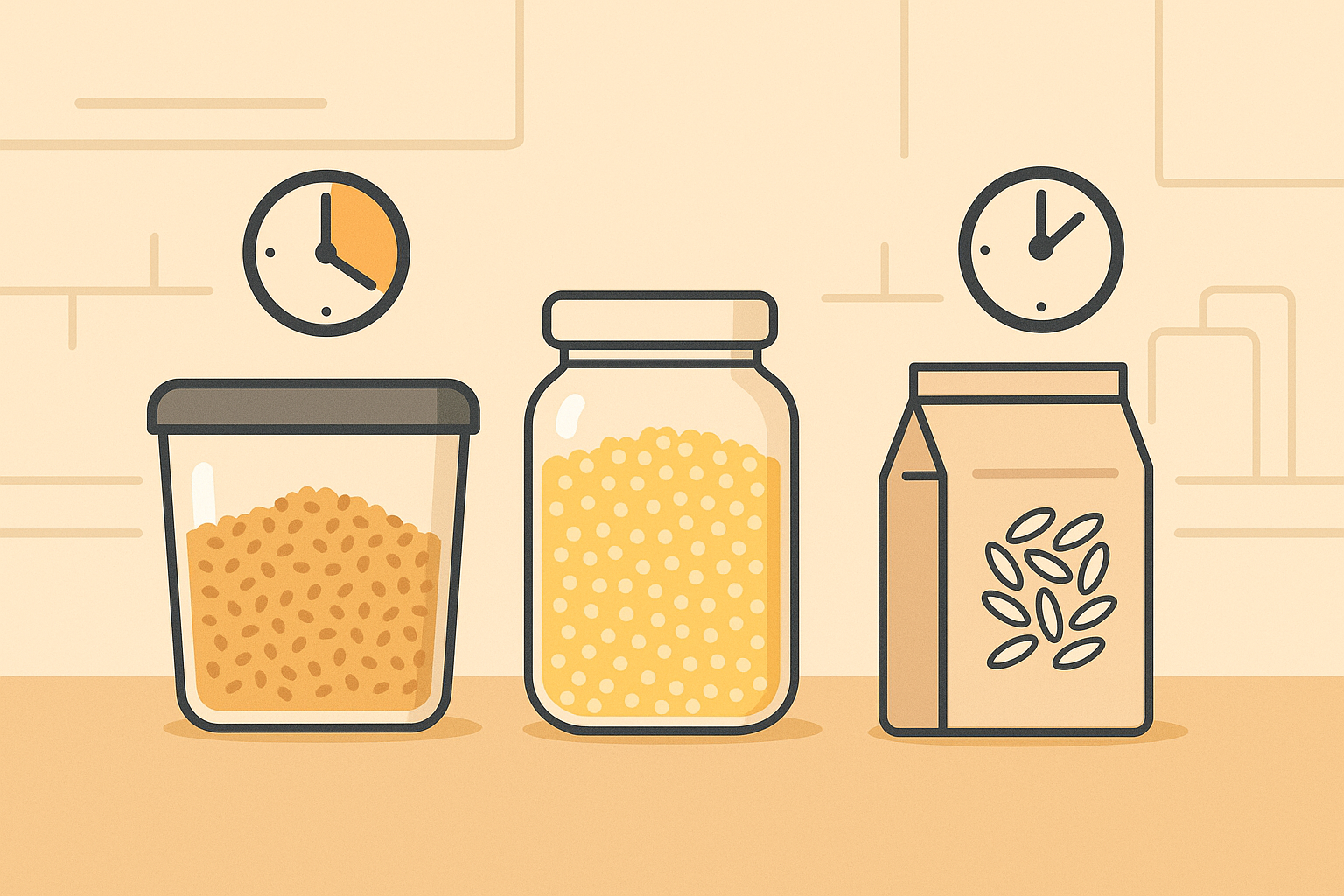
16. Rolled Oats (4g fiber per ½ cup dry)
These are oat groats that have been steamed and flattened, so they cook way faster than steel-cut oats while keeping most of their nutritional benefits. They’re basically the Goldilocks of oats—not too processed, not too time-consuming.
Rolled oats keep that heart-healthy beta-glucan fiber that makes oats so great. You’re getting similar benefits to steel-cut oats with just slightly less mineral content due to the processing. The steaming and rolling is moderate processing, but nothing crazy.
Digestibility is excellent, and oats are super environmentally friendly. The versatility is amazing—breakfast applications, baking recipes, and you can even use them in savory dishes like meatloaf or veggie burgers. They’re basically the Swiss Army knife of grains.
17. Quick-Cooking Barley (6g fiber per cup cooked)
This is pearl barley that’s been pre-steamed to cut down cooking time while keeping most of that impressive fiber content. Instead of waiting 45 minutes, you’re looking at maybe 15-20 minutes, which is a game-changer for weeknight dinners.
Quick-cooking barley still has high beta-glucan fiber content that’s great for heart health. You’re getting selenium, manganese, and phosphorus. It’s moderately processed since it’s been pearled and pre-steamed, but digestibility is actually better because of it.
Barley is a hardy crop that’s good for the environment, and the versatility is excellent. It works beautifully in soups, stews, grain bowls, and risotto-style dishes. It’s like having a shortcut to healthy eating.
18. Instant Brown Rice (4g fiber per cup cooked)
This is pre-cooked and dehydrated brown rice that rehydrates quickly while keeping the fiber content. It’s definitely more processed than regular brown rice, but when you need rice in 10 minutes instead of 50, sometimes that’s the trade-off you make.
Instant brown rice gives you similar fiber content to regular brown rice. Nutritionally, it’s a bit reduced due to processing but still offers essential minerals. The processing is higher since it’s pre-cooked and dehydrated, but digestibility remains really good.
The sustainability is similar to regular rice, and the versatility is excellent for quick meal solutions. When you need rice in minutes rather than hours, this is your friend.
19. Quick Oats (4g fiber per ½ cup dry)
These are more processed than rolled oats—they’re cut into smaller pieces and rolled thinner for faster cooking. You sacrifice some texture for convenience, but they still maintain good nutritional value.
Quick oats keep good beta-glucan content despite the extra processing. Nutritionally, they’re similar to other oat forms with slightly reduced mineral content. The processing is higher due to additional cutting and rolling, but digestibility is still excellent.
They’re environmentally friendly like all oats, and versatility is high for breakfast and baking applications where texture isn’t as critical. They’re perfect for those mornings when you’re running late (which, let’s be honest, is most mornings).
20. Pre-cooked Quinoa (5g fiber per cup)
While technically a seed, quinoa gets used like a grain and offers complete protein along with good fiber content. Pre-cooked versions save serious time since quinoa normally requires careful rinsing and monitoring to avoid bitterness.
Pre-cooked quinoa gives you good fiber content along with that famous complete protein profile. You’re getting iron, magnesium, and all essential amino acids. The processing is higher when pre-cooked, but digestibility remains very good.
Quinoa requires specific growing conditions so sustainability is moderate, but versatility is through the roof. It works in salads, grain bowls, breakfast porridge—pretty much everything. I used to think quinoa was fancy people food until I realized it cooks faster than rice and my kids actually like it.
For crazy busy mornings, I keep a container of mixed quick-cooking grains ready: equal parts rolled oats, quick-cooking barley, and instant brown rice. I portion ½ cup into mason jars with dried fruit and nuts, then just add hot water or milk for an instant high-fiber breakfast that gives me 5+ grams of fiber in under 5 minutes.
Specialty and Unique Options (For Your Adventurous Side)
If you’re ready to venture beyond the grocery store basics and want to feel like a grain explorer, these specialty options offer unique flavors, impressive nutrition, and interesting stories that make meals way more exciting.
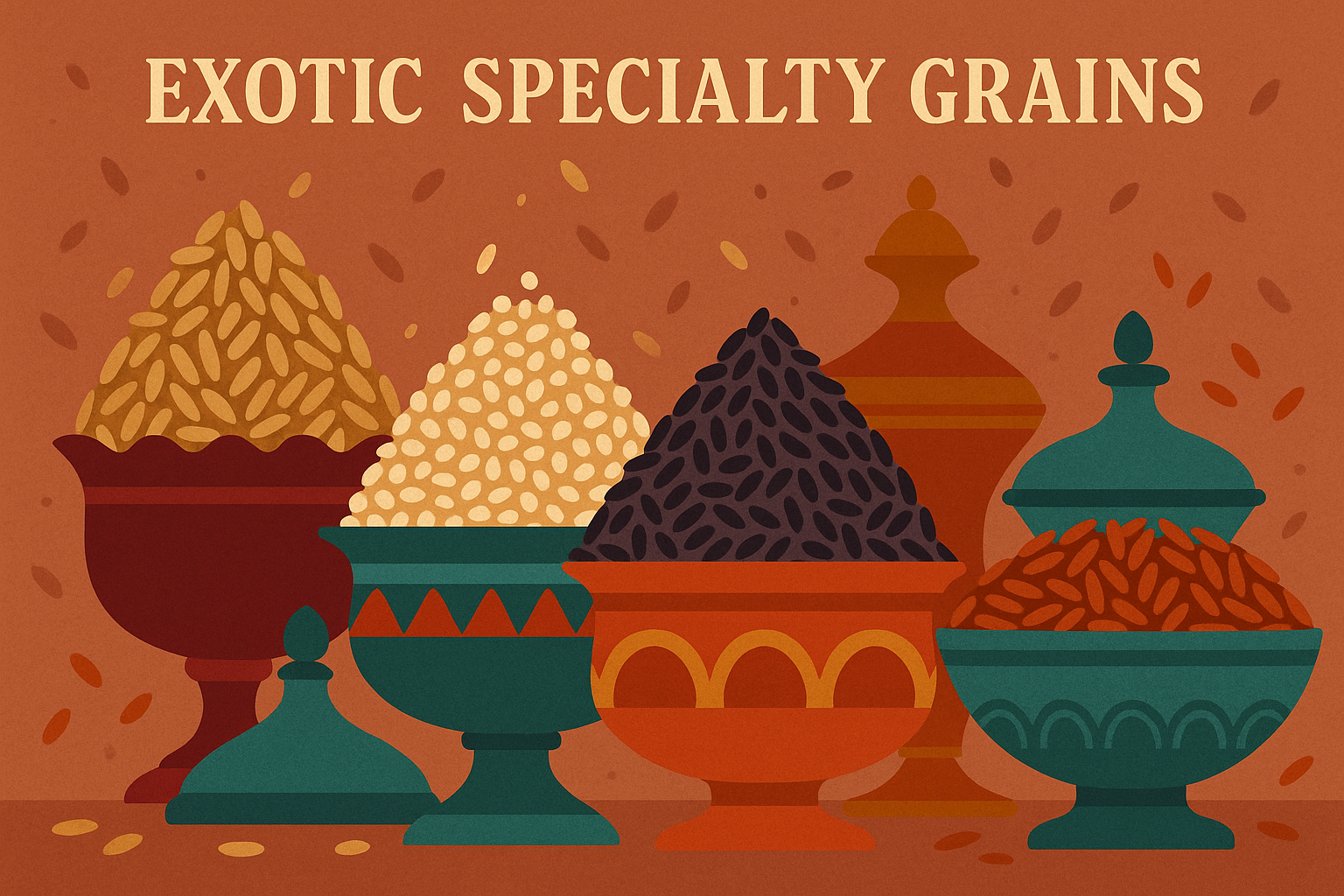
21. Job’s Tears (Coix Seed) (5g fiber per cup cooked)
Job’s tears sounds dramatic, but it’s actually just a chewy grain that won’t make you cry. This Asian grain has been used in Chinese medicine and cuisine for over 4,000 years, so it’s got some serious credibility behind it.
Job’s tears provide good fiber content with traditional medicinal properties that Asian cultures have recognized forever. You’re getting protein and B vitamins. Processing is minimal when hulled, and digestibility is good for most people.
As a traditional crop that’s adapted to Asian growing conditions, it’s pretty sustainable. The versatility is moderate—it works well in Asian dishes,
As a traditional crop that’s adapted to Asian growing conditions, it’s pretty sustainable. The versatility is moderate—it works well in Asian dishes, teas, and grain bowls, though it’s less familiar in Western cooking. Fair warning: you’ll probably have to order this online.
22. Kamut (Khorasan Wheat) (7g fiber per cup cooked)
This ancient wheat variety has these large kernels and a buttery, nutty flavor that’s often easier on people’s stomachs than modern wheat. Kamut is actually a brand name for Khorasan wheat, which has stayed genetically unchanged for thousands of years.
Kamut delivers high fiber content with better digestibility compared to modern wheat varieties. You’re getting protein, selenium, and manganese. Processing is minimal when whole, and digestibility is better than modern wheat (though it still contains gluten).
Since this ancient variety is adapted to harsh conditions and needs fewer inputs, it’s better for the environment. You can substitute it for other wheat varieties in most applications. It’s like wheat’s cooler, more ancient cousin.
23. Triticale (6g fiber per cup cooked)
Triticale is what happens when wheat and rye have a baby—it’s a hybrid grain that combines the benefits of both parent grains with good fiber content. It was developed in the late 19th century to get wheat’s baking qualities with rye’s hardiness.
Triticale gives you high fiber from both wheat and rye genetics, creating this unique nutritional profile. You’re getting protein, lysine (which is often limited in grains), and B vitamins. Processing is minimal when whole, and digestibility is good (gluten alert).
It combines the hardiness of both parent grains, so it needs fewer inputs than many modern varieties. You can use it similarly to wheat or rye in most applications. It’s basically the best of both worlds.
24. Ethiopian Blue Barley (8g fiber per cup cooked)
Ethiopian blue barley is like the Instagram influencer of grains—pretty and good for you. This heritage barley variety has this distinctive blue color and nutty flavor, and it’s exceptionally high in fiber and antioxidants.
Ethiopian blue barley delivers very high fiber content with significant antioxidant benefits from that blue pigmentation. You’re getting anthocyanins, protein, and minerals. Processing is minimal as a hull-less variety, and digestibility is good.
Since it’s adapted to harsh growing conditions with minimal inputs required, it’s excellent for sustainability. The versatility is moderate—it’s definitely a specialty grain that’s perfect when you want to showcase its distinctive color and flavor.
25. Emmer (7g fiber per cup cooked)
Emmer is one of the oldest cultivated wheats with this complex nutty flavor and excellent nutritional profile. This ancient grain was a staple in ancient Egypt and Rome, and it’s having a renaissance among people who actually care about what they eat.
Emmer provides high fiber content with good digestibility despite being an ancient wheat variety. You’re getting protein, iron, magnesium, and antioxidants. Processing is minimal when whole, and digestibility is better than modern wheat (contains gluten though).
As an ancient variety that needs fewer inputs than modern wheat, it’s excellent for sustainability. The versatility is high—it works beautifully in pasta, bread, grain bowls, and risotto-style dishes. It’s basically ancient wheat that never sold out.
| Grain Category | Average Fiber | How Processed | Cooking Time | Where to Find It |
|---|---|---|---|---|
| Ancient Powerhouses | 7-8g per cup | Barely | 45-90 min | Health food stores |
| Everyday Staples | 3-6g per cup | Minimal to Low | 20-90 min | Everywhere |
| Gluten-Free Champions | 2.3-6.7g per cup | Minimal | 20-60 min | Most stores |
| Quick-Cooking Options | 4-6g per serving | Moderate | 5-20 min | Everywhere |
| Specialty Varieties | 5-8g per cup | Minimal | 45-90 min | Online/specialty |
The Organic Authority Approach to High-Fiber Whole Grains
Look, if you’re reading this, you probably care about more than just hitting some arbitrary fiber number. You want to make choices that are good for your body and don’t trash the planet in the process. At Organic Authority, we get that true wellness isn’t just about checking boxes—it’s about making thoughtful choices that support both your health and the environment.

When you’re picking from these 25 high-fiber grains, try to source them from local farmers markets when you can, just like you would with fresh produce. A lot of these ancient and heritage varieties are being brought back by small-scale organic farmers who actually care about preserving biodiversity and soil health. Choosing organically grown whole grains means you’re avoiding synthetic pesticides and fertilizers while supporting farming practices that build up the earth instead of depleting it.
Understanding the bigger picture of why dietary fiber is the real macronutrient you need to watch helps put these grain choices into perspective within a holistic approach to actually feeling good.
The beautiful thing about getting these high-fiber foods into your daily routine is how versatile they are and how they can transform simple ingredients into meals that actually nourish you and fill you up. Whether you’re making a warming bowl of steel-cut oats topped with whatever fruit is in season, crafting a hearty farro salad with farmers market vegetables, or experimenting with ancient grains like teff and amaranth, you’re participating in food traditions that span cultures and centuries.
For getting the most out of your grain prep, check out how to make oatmeal perfect every time as a foundation for working with various whole grain breakfast preparations.
Remember, getting to optimal digestive health through high-fiber whole grains is totally personal and should be approached gradually. Start with familiar options like brown rice and oats, then slowly explore more adventurous choices like freekeh or Ethiopian blue barley. Your body—and the planet—will thank you for choosing these nutrient-dense, sustainably grown whole grains that represent the very best of conscious, healthful eating.
Making these high-fiber whole grains a cornerstone of your clean eating routine means you’re not just nourishing your body with essential nutrients and beneficial fiber—you’re also voting with your dollar for a more sustainable, health-conscious food system that prioritizes both human and environmental wellness. Organic Authority supports this journey by providing resources, recipes, and guidance to help you navigate the world of sustainable, high-fiber nutrition with confidence and success.
Final Thoughts
Your journey toward better digestive health through high-fiber whole grains doesn’t have to feel overwhelming or like you’re signing up for a lifetime of cardboard-flavored meals. These 25 options give you a solid foundation for transforming how you eat while supporting farming practices that don’t destroy the planet.
Start with grains that actually sound good to you, then gradually expand your repertoire as your taste buds and digestive system get used to the changes. Don’t feel like you need to become a grain guru overnight—even adding one new high-fiber grain to your rotation can make a real difference in how you feel.
The key to actually sticking with this is viewing these grains not as dietary punishment but as delicious, versatile ingredients that can make every meal more interesting and satisfying. Whether you’re drawn to the convenience of quick-cooking options, the nutritional density of ancient grain powerhouses, or the safety of gluten-free champions, there’s definitely a high-fiber whole grain that fits your lifestyle and health goals.
Look, you don’t need to overhaul your entire pantry tonight. Pick one grain that sounds interesting, buy a small bag, and see how it goes. Your digestive system (and your taste buds) will figure out the rest as you go along. Remember that sustainable change happens gradually—your gut needs time to adjust to increased fiber intake, and your cooking skills will develop as you experiment with new grains and preparation methods.
Focus on progress rather than perfection, and celebrate each step toward better health through conscious, fiber-rich food choices that make you feel good instead of guilty. Because at the end of the day, good food should make you feel good, not like you’re doing penance for enjoying a meal.

